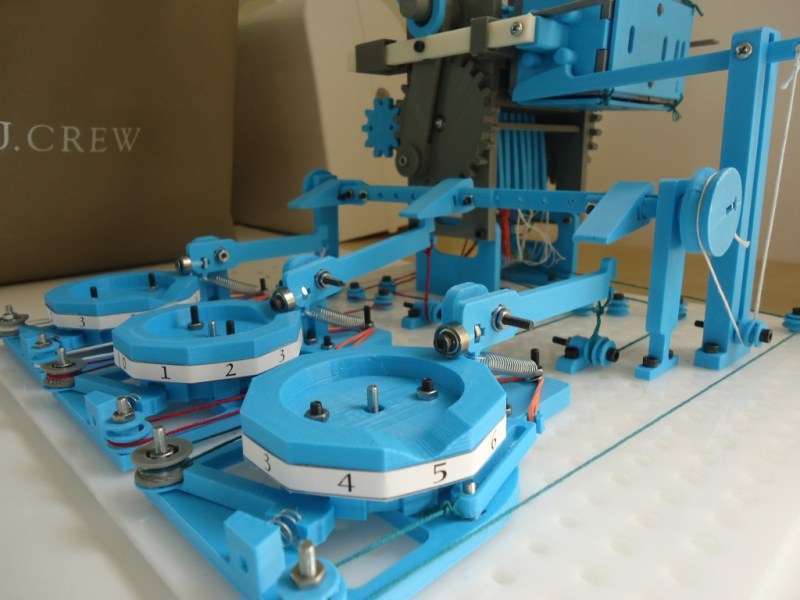What a beautiful thing it is to see this digital computer in action. [Chris Fenton] did an amazing job of designing and printing this mechanical digital computer. If you’re interested in one to call your own check out the source files he published this week.
[Chris’] design inspiration came from some research into Victorian Era mechanical looms. He adjusted the concept to build a punch card reader, starting with a capacity of three holes and moving to this design which can read ten holes. It provides just enough bits to address all three of the counters pictured above. Program the computer by inserting a punch card that is the size of a business card and crank away. The video below shows the process from afar… hopefully he’ll post a follow-up video with closer views of each piece in action.
This isn’t his first basic computing machine. Check out the electromechanical version from last year.
[Thanks Maarten]
















Wouldn’t this technically be Analog…?
From the wikipedia article on ‘digital’: “In information theory and information systems, digital refers to a technology that uses discrete, discontinuous representations of information or works in a discontinuous manner.”
So no, this is digital.
With this definition more ‘analog’ stuff is ‘digital’, like analog clocks…
Not really. The minutes/hours on the clock are marked in discrete places, but the arms move in an analog manner. Unless you mean one of those old school clocks, the seconds are digital, though.
No they move in discrete steps but the steps are so small and happen so fast it looks like a sweep and continuous movement.
The steps are controls by the escapement which turns the gears in fixed steps so many times a second (otherwise it’d lose time!).
Sand timers are analogue but even they are discrete steps when you look close enough (Sand grains)
Ultimately we believe the fabric of the universe is split into discrete plank sized amounts (or even bigger if you prescribe to the holographic principle of the universe).
Analogue is a theoretical concept!
Mind blown? It should be.
Analog = continuous
Digital = discrete
If you haven’t looked at the YouTube videos on here about “mechanical targeting computers” before, you should. It’ll help you remember what continuous and discrete mean.
While this is technically a digital computer, it is not using pure logic like a transistor-based computer. I would love to see someone make something like a 4-bit adder from mechanical transistors, but I’m very aware how unnecessarily abstract that would be. :-)
Quote: “it is not using pure logic like a transistor-based computer”
Ummm, yeah it is.
Both logic and math do not exist. They are only a human expression that are used to specify a behaviour.
However logic is a form of math and therefore it is not limited to binary.
This unit has both binary and digital logic. The displays are digital in the base of 10. The three levers form an OR (Gate) logic in the base of 2 ie binary.
So this is a State Computer made a physical medium.
How about adder from mechanical flip-flops like this http://makezine.com/projects/make-20/marble-adding-machine/ or even this https://www.youtube.com/watch?v=zELAfmp3fXY&feature=player_embedded#at=76 ?
Kind of annoyed by his ‘hijacking’ the name Turbo Encabulator, but a great piece of work regardless!
In fairness, it says turbo enTabulator.
Love it, no idea whats actually happening in the video but the click clack is awesome.
You turn the crank, which snaps the plank, which boots the marble right down the chute, now watch it roll, and hit the pole, knocks the ball in the rub-a-dub tub, which puts the man, into the pan, the trap is set, here comes the… umm next digit.
Did anybody else have a Think-a-tron?
I found one and use it with my Digital Electronics class to demo punch cards – which are new to them.
This should get the useless machine award. Think they could of engineered a better platform? Them holding it really kills the moment. Oh and what exactly is this capable of computing?
This looks to me like the first step on the long road to printing micro-scale transistors at home.
Genius at work. It took a long time to build this.